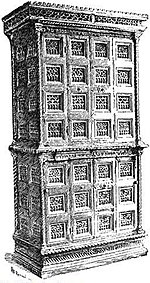Torah ark

Torah Ark of the Szeged Synagogue
The ark in a synagogue (also called the Torah ark or holy ark) is a receptacle,or ornamental closet, which contains each synagogue's Torah scrolls (Sifrei Torah in Hebrew).[1]
Contents
1 History
2 Gallery
3 References
4 External links
History

Bnei Brak, Israel
Aron kodesh comes from Hebrew .mw-parser-output .script-hebrew,.mw-parser-output .script-Hebr{font-size:1.15em;font-family:"Ezra SIL","Ezra SIL SR","Keter Aram Tsova","Taamey Ashkenaz","Taamey David CLM","Taamey Frank CLM","Frank Ruehl CLM","Keter YG","Shofar","David CLM","Hadasim CLM","Simple CLM","Nachlieli","SBL BibLit","SBL Hebrew",Cardo,Alef,"Noto Serif Hebrew","Noto Sans Hebrew","David Libre",David,"Times New Roman",Gisha,Arial,FreeSerif,FreeSans}אָרוֹן קׄדֶש ʼārōn qōdeš (i.e. aron kodesh), Holy Ark. This name is a reference to the ’ārōn haqqōdeš, the Hebrew name for the Ark of the Covenant which was stored in the Holy of Holies in the inner sanctuary of both the ancient Tabernacle and the Temple in Jerusalem. Similarly, Hekhál, also written hechal, echal or heichal — and sometimes also Echal Kodesh (mainly among Balkan Sephardim) comes from Hebrew הֵיכָל [hēkhāl] ‘palace’, was used in the same time period to refer to the inner sanctuary. The hekhal contained the Menorah, Altar of Incense, and Table of the Showbread.

Modena, Italy (1505)
Most arks feature a parokhet (curtain) placed either outside the doors of the holy ark (Ashkenazi and Mizrachi custom) or inside the doors of the ark (Spanish and Portuguese and Moroccan Sephardi custom). The ark is known in Hebrew as the aron kodesh ("holy ark") by the Ashkenazim and as the 'menjia ("holy place") among most Sefardim.
The ark is often placed on the wall of the sanctuary which is facing Jerusalem, though it is sometimes placed on the north wall or another wall for architectural reasons. In those cases where the ark does not show the direction to Jerusalem, traditional Judaism instructs the worshiper to face the true direction towards Jerusalem in prayers such as the Amidah.
In some ancient synagogues, such as the fifth-century synagogue in Susia, the Torah scroll was not placed inside the synagogue at all, but in a room adjacent to it, signifying that the sacredness of the synagogue does not come from the ark but from its being a house of prayer. The Torah was brought into the synagogue for reading purposes.
Gallery

Beth Jakov synagogue in Macedonia
Western Wall, Wilson's Arch area, Jerusalem

Ari Ashkenazi Synagogue, Safed, Israel

Abuhav synagogue, Safed, Israel

Cedar, Jerusalem stone, and bronze Torah ark for Lincoln Square Synagogue, New York City (2013), by artist David Ascalon

Novi Sad, Serbia

Kraków, Poland

Włodawa Synagogue, Włodawa, Poland
Pfaffenhoffen, Alsace

Ark based on a Chinese Buddhist design used by the Kaifeng Jews of China

Ark decorated for Shavuot, Encino, California, United States

Esnoga, Amsterdam, Netherlands

Synagogue in Győr, Hungary
References
^ Wischnitzer, Rachel, and Bezalel Narkiss (2007). "Ark." Encyclopaedia Judaica. 2nd ed. Vol. 2. Detroit: Macmillan Reference USA, 2007. p. 463-464.
External links
| Wikimedia Commons has media related to Torah_arks. |
“Aron Kodesh” in Jewish Encyclopedia












